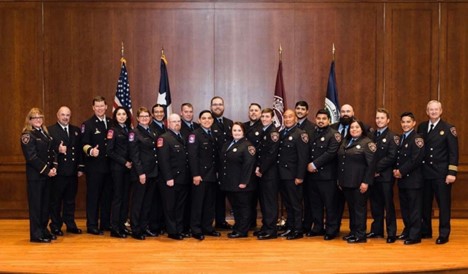Monday, August 1, 2022, was a typical San Antonio, Texas, summer day, with clouds hanging low and humidity increasing as the sun rose. But nothing was ordinary to the 20 individuals who would become cadets in the first Emergency Management Academy developed by the Texas Division of Emergency Management (TDEM). Looking around, the cadets appeared apprehensive but excited that they had been selected to become the future of emergency management in the Lone Star State. TDEM Chief Nim Kidd spoke to the class and shared his expectations of The Academy. He indicated that the cadet demographics were intentionally diverse: military veterans, college graduates, recent high school graduates, and practitioners from fire, emergency medical services (EMS), and law enforcement backgrounds. The purpose was to garner different perspectives inherent to the cooperative and collaborative nature of the emergency management field.
Emergency Medical Technician – Basic
After onboarding into The Texas A&M University System, the cadets moved to a different location from its roots in the Texas A&M–San Antonio campus to the Schertz EMS Academy in Guadalupe County. There, the cadets underwent a rigorous, condensed eight-week training (from the standard 16-week course) in emergency medical response, undergoing testing in academics and skills. Also, the practical application portion of the training was supplemented by clinical familiarity through ambulance duty on weekends, in which the cadets had to complete 40 hours of assisting ambulance crews. The final test was the National Registry exam, in which the nationally recognized EMS certification was awarded. The emergency medical response certification would enhance the cadet’s ability to augment EMS in their jurisdictions after graduating from the Academy.
Preparedness – Planning During “Blue Sky” Days
The cadets went back to the Texas A&M–San Antonio campus for the duration of The Academy. Before diving into the Preparedness training module, the cadets received a week-long series of classes on leadership development, team building, and stress management. Then, they took courses on the Foundations of Emergency Management, Science of Disasters, Emergency Planning, Homeland Security Exercise and Evaluation Program, Threat and Hazard Identification and Risk Assessment, and Continuity of Operations. The cadets also became intimate with the federal laws governing emergency management, specifically the Stafford Act and the Texas Government Code Chapter 418, the state’s statutory authority on disaster management. Additionally, the cadets were introduced to the State of Texas Emergency Assistance Registry, a program administered locally for citizens with access and functional needs, and the Emergency Tracking Network, where they learned to track evacuees and pets.
Hazard Mitigation Training – State and Federal Perspectives
The complexity of hazard mitigation was navigating through the idiosyncrasies of the various federal hazard mitigation programs and the processes from applying for the grant programs at the local level to the programmatic closeout between TDEM and the Federal Emergency Management Agency (FEMA). The instructors hailed from TDEM, giving the cadets the state-level perspectives, and FEMA Region 6, headquartered in Denton, Texas, providing the federal-level views. Also, the cadets observed that other state agencies, such as the General Land Office and the Texas Water Development Board, were instrumental in providing additional funding assistance for hazard mitigation. The classes familiarized the cadets with the various funding assistance programs and their applications, conducting benefit-cost analyses, and grant application reviews and evaluations.
Response – “How Big Is Big? How Bad Is Bad?”
The cadets welcomed the New Year in 2023 with two weeks of the Incident Command System (ICS) for Expanding Incidents (G-300 and G-400), followed by Public Information Basics, in which TDEM’s own Media and Communications team interviewed the cadets who subsequently conducted press conferences fielding questions from the “press.” The cadets were then introduced to various Geographic Information System platforms such as Survey 123, Individual (Assistance) State of Texas Assessment Tool (iSTAT), Public (Assistance) State of Texas Assessment Tool (pSTAT), State of Texas Assistance Request (STAR), and WebEOC, the resource request tracking tool from local jurisdictions to the Texas State Operations Center (SOC). The data collected from the iSTAT and pSTAT digital surveys give an overview of the initial damage assessment for the Disaster Summary Outline (DSO). The DSO is transmitted to the SOC to assist in evaluating the extent of the damage within a jurisdiction.
“Every Day Is Recovery Day” Training
The recovery training module started with grant management for both Individual Assistance and Public Assistance programs. Emergency declarations and disaster declarations were also covered, starting with requests from the local level up to the president’s approval. Further, there was an emphasis on the importance of a debris management plan, as well as the roles of community leaders in disaster declarations, sheltering and feeding operations, engaging Volunteer Organizations Active in Disasters and Community Organizations Active in Disasters, establishing a Long-Term Recovery Group, and choosing a fiduciary agent (a third-party entity to assist in processing monetary donations during disasters). An added feature was education in Disaster Finance, taught by a team from TDEM that manages and allocates federal and state funds to individual jurisdictions.
Off-Site Training
Although most of the training took place on the Texas A&M–San Antonio campus, the cadets had the opportunity to train off-site. The first field experience was on Sunday, November 20, 2022, attending the Texas EMS Conference in Austin, Texas, where they were introduced to the various Emergency Medical Task Force (EMTF) teams throughout the state and the different types of assets, including mobile medical units. They also explored various technological advances in emergency response by talking to the vendors in the exhibit hall. A great event was experienced by all when the Emergency Operations Center (EOC) Operations and Planning class met in the Bexar County/City of San Antonio EOC to conduct scenario-based training in an actual EOC. Instructors from the Texas A&M Engineering Extension Service (TEEX) guided the cadets in operating an EOC by filling the roles in an ICS framework. The cadets also had the opportunity to tour the SOC in Austin, where they were introduced to the various emergency support functions (ESFs) and how the SOC would operate during activations. Moreover, during the recovery training phase, the cadets visited the San Antonio Food Bank to acclimate to its mission, capabilities, and valuable role in disaster resource assistance.
Job Fair – “The Academy Mixer”
To fully understand the uniqueness of each region and functional area within TDEM, and before applying for employment, cadets participated in a job fair organized by the TDEM Administration Division and the Human Resources team. To prepare for the job fair, cadets took classes on resume building, cover letter drafting, and job interview techniques.
Capstone – The Final Phase of the Emergency Management “Boot Camp”
The Academy Capstone took place over three days in late March at Disaster City in College Station. Hosted by TEEX, the multi-day exercise consisted of filling the roles of the ICS functions within the EOC. The simulation was divided into multiple operational periods wherein cadets switched roles. This “final project” enhanced the exercise’s realism and gave the cadets confidence in performing the essential tasks during disaster operations.
Reflections
The challenging yet fulfilling experience culminated at 4 p.m. on Friday, March 24, 2023, when 17 cadets walked across the stage to receive their diplomas, FEMA certificates, and badges – part of their reward for completing the 8-month “basic training” in emergency management. The keynote speaker was Governor Greg Abbott. Texas A&M University System Chancellor John Sharp, Texas Emergency Management Chief Nim Kidd, FEMA Region 6 Administrator Tony Robinson, and TDEM Academy Division Chief David Covington also delivered remarks. This academy cohort was unique for two reasons: This was a new and unique emergency management academy and this was the first cadet class to go through the training – an opportunity of a lifetime! Familiarization with the four phases of emergency management, receiving FEMA and EMS certifications, networking opportunities, and, most of all, performing the skills requirements of the emergency management field was a tremendous experience! The 17 cadets that completed the training became family, dedicated and eager to respond to assist the citizens of Texas as the next generation of emergency managers.
The author would like to especially thank TDEM Division Chief David Covington, Unit Chief Kade Long, and Unit Chief Angela Shook for their leadership and academic acumen in sustaining The Academy.

Michael Valiente
Michael Valiente is the senior training officer of the Training Division at the Texas Division of Emergency Management. He is a retired U.S. Marine with 23 years of active-duty service. He did two tours as an instructor and academics supervisor with Marine Corps University and one tour as a Marine Embassy Guard with the U.S. State Department. His initial emergency management experience came from participating in Operational Unified Assistance, the U.S. military humanitarian relief efforts during the December 2004 tsunami in Southeast Asia. After retiring in 2005, he taught at the University of Phoenix and Alamo Colleges in San Antonio, Texas. He has a master’s degree in international relations from Troy University and a Doctor of Emergency Management degree from Capella University.
-
Michael Valientehttps://www.domesticpreparedness.com/author/michael-valiente
-
Michael Valientehttps://www.domesticpreparedness.com/author/michael-valiente
-
Michael Valientehttps://www.domesticpreparedness.com/author/michael-valiente
-
Michael Valientehttps://www.domesticpreparedness.com/author/michael-valiente






